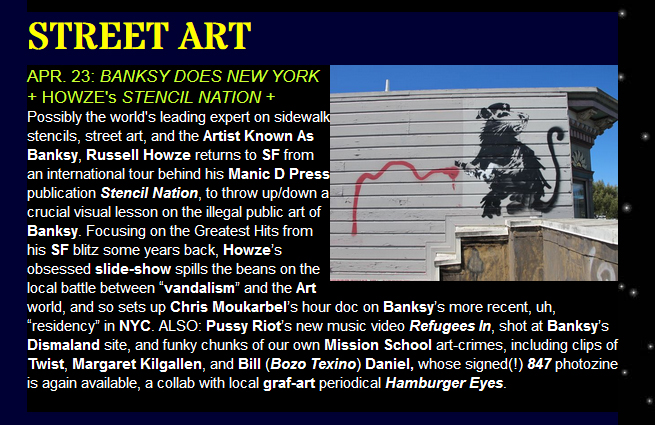Sat.-23 APRIL: Stencil Nation at Other Cinema/ATA, SF
 I promise you all, I'll do my best to answer your questions and quench your curiosities. Meanwhile, a teaser of a slide that may just say it all... or be as thing as the paint pigment upon a cinder block wall. - Russell
I promise you all, I'll do my best to answer your questions and quench your curiosities. Meanwhile, a teaser of a slide that may just say it all... or be as thing as the paint pigment upon a cinder block wall. - Russell
STREET ART
APR. 23: BANKSY DOES NEW YORK + HOWZE's STENCIL NATION +
Possibly the world's leading expert on sidewalk stencils, street art, and the Artist Known As Banksy, Russell Howze returns to SF from an international tour behind his Manic D Press publication Stencil Nation, to throw up/down a crucial visual lesson on the illegal public art of Banksy. Focusing on the Greatest Hits from his SF blitz some years back, Howze’s obsessed slide-show spills the beans on the local battle between “vandalism” and the Art world, and so sets up Chris Moukarbel’s hour doc on Banksy’s more recent, uh, “residency” in NYC. ALSO: Pussy Riot’s new music video Refugees In, shot at Banksy’s Dismaland site, and funky chunks of our own Mission School art-crimes, including clips of Twist, Margaret Kilgallen, and Bill (Bozo Texino) Daniel, whose signed(!) 847 photozine is again available, a collab with local graf-art periodical Hamburger Eyes.
Other Cinema shows films every Saturday at ATA Gallery, 992 Valencia (@ 21st). Showtime 8:30pm, admission* $7.

 Mural of rare yellow-billed cuckoos is a mix of social commentary and environmental conservation
Mural of rare yellow-billed cuckoos is a mix of social commentary and environmental conservation VELVETEEN ANGEL
VELVETEEN ANGEL <<< SMiLE in Boulder, CO
<<< SMiLE in Boulder, CO <<< Le Loup (Hamburg); photo by TXMX
<<< Le Loup (Hamburg); photo by TXMX <<< Zabou in Berlin (photo by TXMX)
<<< Zabou in Berlin (photo by TXMX)
